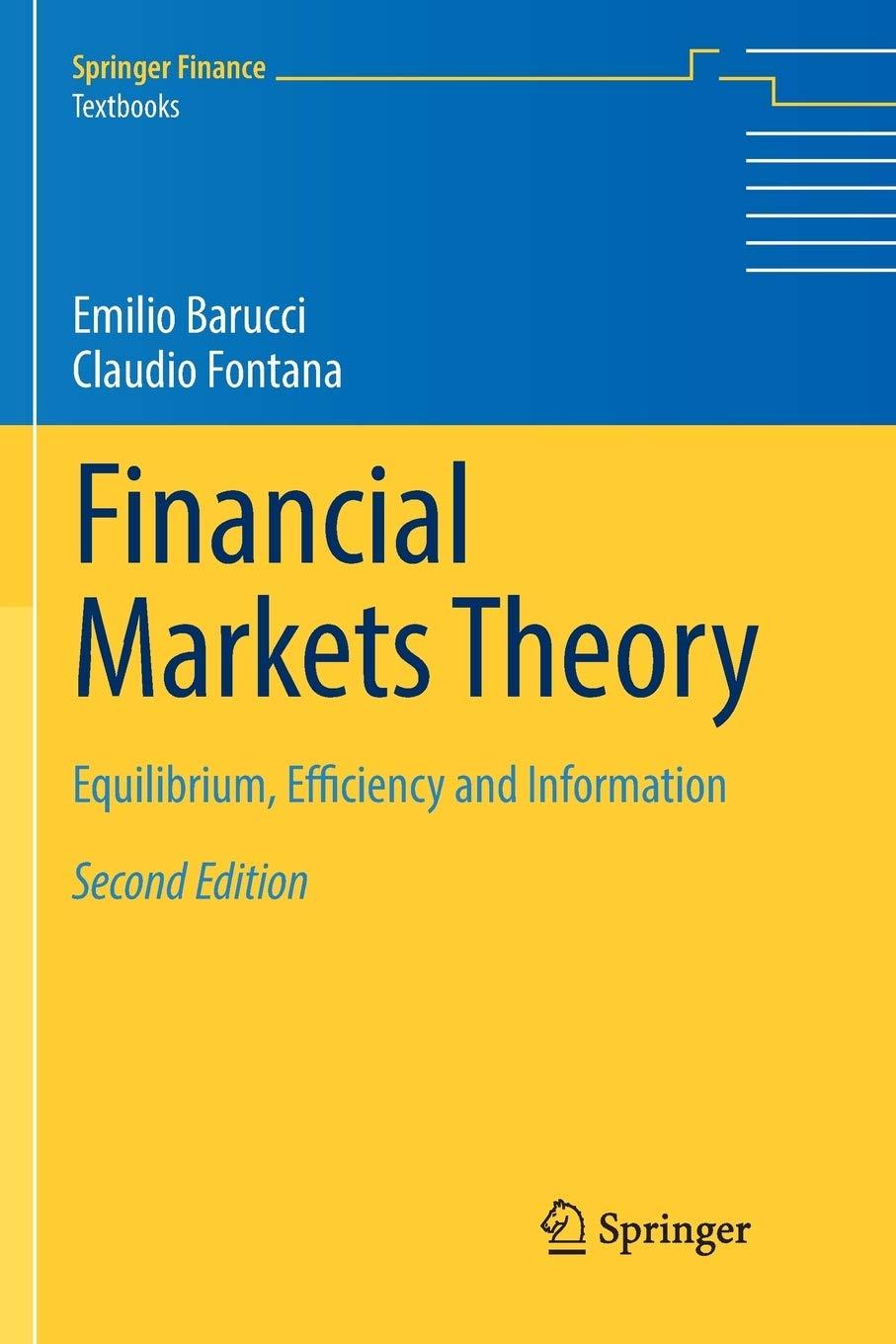Consider an economy with two trading dates (t in{1,2}) and two traded assets: a riskless asset with
Question:
Consider an economy with two trading dates \(t \in\{1,2\}\) and two traded assets: a riskless asset with constant rate of return \(r_{f}=1\) and a risky asset whose liquidation value after date \(t=2\) is given by the random variable
\[\tilde{f}=\bar{f}+\tilde{\theta}+\tilde{\varepsilon}\]
where \(\mathbb{E}[\tilde{\theta}]=\mathbb{E}[\tilde{\varepsilon}]=0\) and the couple \((\tilde{\theta}, \tilde{\varepsilon})\) follows as a bivariate normal distribution with independent components, with \(\operatorname{Var}(\tilde{\theta})=: \sigma_{\theta}^{2}\) and \(\operatorname{Var}(\tilde{\varepsilon})=: \sigma_{\varepsilon}^{2}\).
The economy is populated by a continuum of agents indexed in the interval \([0, N]\). All agents are assumed to have negative exponential utility functions with a common risk aversion parameter \(a\). In this economy, there are early informed and late informed agents. More specifically, a mass \([0, M]\) of the total population \([0, N]\) of agents is early informed, meaning that at date \(t=1\) they can observe the realization of the random variable \(\tilde{\theta}\). On the other hand, late informed agents can only observe the realization of \(\tilde{\theta}\) at the successive date \(t=2\). The error term \(\tilde{\varepsilon}\) remains unobservable to both classes of agents. Furthermore, every agent is assumed to have an initial endowment of \(e_{0}\) units of the riskless asset.
Besides early and late informed agents, there are also liquidity traders, whose net trades (demand shocks) at dates \(t=1\) and \(t=2\) are represented by the random variables \(\tilde{z}_{1}\) and \(\tilde{z}_{2}\), respectively. The random variables \(\tilde{z}_{1}\) and \(\tilde{z}_{2}\) are normally distributed, with zero mean and variance \(\operatorname{Var}\left(\tilde{z}_{1}\right)=\operatorname{Var}\left(\tilde{z}_{2}\right)=: \sigma_{z}^{2}\) and are mutually independent as well as independent of \((\tilde{\theta}, \tilde{\varepsilon})\).
Finally, besides early and late informed agents and liquidity traders, there is a group of competitive risk neutral market makers, who possess no information on the fundamental value of the risky asset. Market makers are willing to absorb the net demand of the other traders at competitive prices.
If we denote by \(\mathscr{G}_{1}\) and \(\mathscr{G}_{2}\) the information sets of the early informed agents at date \(t=1\) and \(t=2\), respectively, then the information set of the late informed agents at date \(t=2\) coincides with \(\mathscr{G}_{2}\), while the information set of the late informed agents at \(t=1\) coincides with the information set of the risk neutral market makers (which contains only the observation of the aggregate demand or, equivalently, the equilibrium price functional). As usual, all the agents are assumed to rationally extract information from the observation of equilibrium prices. Letting \(p_{1}\) and \(p_{2}\) denote the price of the risky asset at dates \(t=1\) and \(t=2\), respectively, we denote by \(x_{1}\left(\theta, p_{1}\right)\) and \(x_{2}\left(\theta, p_{2}\right)\) the demand of an early informed agent at \(t=1\) and \(t=2\), respectively, and by \(y_{1}\left(p_{1}\right)\) and \(y_{2}\left(\theta, p_{2}\right)\) the demand of a late informed agent at \(t=1\) and \(t=2\), respectively. Taking into account the effect of the liquidity traders, the net aggregate demands are then given by \[\begin{aligned}
D_{1}\left(p_{1}\right) & :=M x_{1}\left(\theta, p_{1}\right)+(N-M) y_{1}\left(p_{1}\right)+\tilde{z}_{1} \\
D_{2}\left(p_{2}\right) & :=M x_{2}\left(\theta, p_{2}\right)+(N-M) y_{2}\left(\theta, p_{2}\right)+\tilde{z}_{1}+\tilde{z}_{2}
\end{aligned}\]
at \(t=1\) and \(t=2\), respectively. Since market makers are risk neutral and competitive, they set prices which are equal to the expectation of the terminal value of the risky asset conditionally on their information set (which only consists of the aggregate demand function of all other traders), so that \[\begin{equation*}
p_{1}=\mathbb{E}\left[\tilde{f} \mid D_{1}(\cdot)\right] \quad \text { and } \quad p_{2}=\mathbb{E}\left[\tilde{f} \mid D_{1}(\cdot), D_{2}(\cdot)\right] \tag{8.46}
\end{equation*}\]
(i) Let us conjecture that the equilibrium price functional is of the form \[\begin{aligned}
& p_{2}=\phi_{2}^{*}\left(\bar{f}, \theta, z_{1}, z_{2}\right)=\bar{f}+\alpha \theta+\beta z_{1}+\gamma z_{2} \\
& p_{1}=\phi_{1}^{*}\left(\bar{f}, \theta, z_{1}\right)=\bar{f}+\eta \theta+\phi z_{1}, \end{aligned}\]
where \(\alpha, \beta, \gamma, \eta, \phi\) are suitable coefficients to be determined. Show that in correspondence of the equilibrium prices the optimal demands of the early and late informed agents are given by \[\begin{align*}
x_{2}\left(\theta, p_{2}\right)= & y_{2}\left(\theta, p_{2}\right)=\frac{\bar{f}+\theta-p_{2}}{a \sigma_{\varepsilon}^{2}} \tag{8.47}\\
x_{1}\left(\theta, p_{1}\right)= & \frac{\mathbb{E}\left[\phi_{2}^{*}\left(\bar{f}, \tilde{\theta}, \tilde{z}_{1}, \tilde{z}_{2}\right) \mid \mathscr{G}_{1}\right]-p_{1}}{a}\left(\frac{1}{\operatorname{Var}\left(\phi_{2}^{*}\left(\bar{f}, \tilde{\theta}, \tilde{z}_{1}, \tilde{z}_{2}\right) \mid \mathscr{G}_{1}\right)}+\frac{1}{\sigma_{\varepsilon}^{2}}\right) \\
& +\frac{\bar{f}+\theta-\mathbb{E}\left[\phi_{2}^{*}\left(\bar{f}, \tilde{\theta}, \tilde{z}_{1}, \tilde{z}_{2}\right) \mid \mathscr{G}_{1}\right]}{a \sigma_{\varepsilon}^{2}} \tag{8.48}\\
y_{1}\left(p_{1}\right)= & 0 . \tag{8.49}
\end{align*}\]
(ii) As shown in Hirshleifer et al. [947, Lemma 1], the conjectured price functional is indeed the equilibrium price functional and the coefficients \(\alpha, \beta, \gamma, \eta, \phi\) can be explicitly determined. Moreover, it holds that \(\eta \in(0,1)\) and \(\alpha>\eta\). In this case, show that \[\begin{equation*}
\operatorname{Cov}\left(\phi_{1}^{*}\left(\bar{f}, \tilde{\theta}, \tilde{z}_{1}\right)-\bar{f}, \tilde{\theta}\right)>0 \quad \text { and } \operatorname{Cov}\left(\phi_{2}^{*}\left(\bar{f}, \tilde{\theta}, \tilde{z}_{1}, \tilde{z}_{2}\right)-\phi_{1}^{*}\left(\bar{f}, \tilde{\theta}, \tilde{z}_{1}\right), \tilde{\theta}\right)>0 \tag{8.50}
\end{equation*}\]
Step by Step Answer:

Financial Markets Theory Equilibrium Efficiency And Information
ISBN: 9781447174042
2nd Edition
Authors: Emilio Barucci, Claudio Fontana





